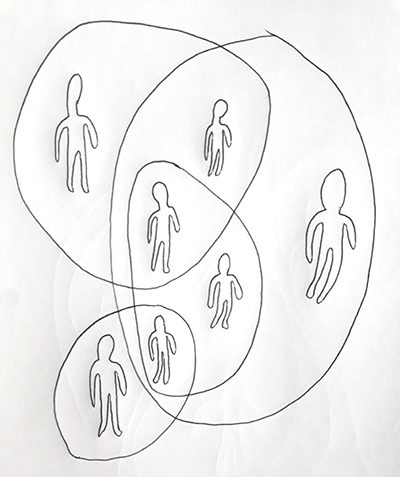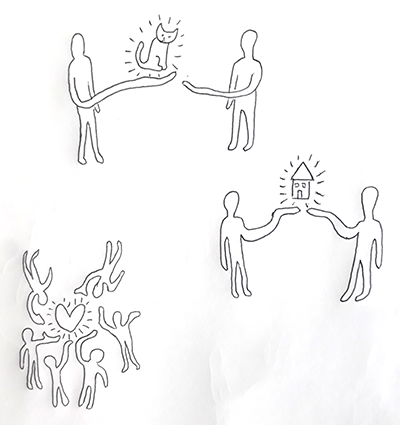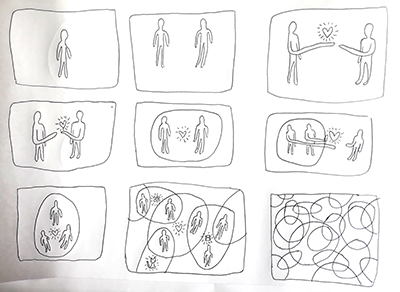starting with the inderduction in social practice, we read a text by Massey Doreen: "space, race and gender". Doreen talks about places as a process and a zoom-in in a net of connection, rather then a geographical place. I thought this was very interessting as there is the idea of a huge net that connects everything with each other.
Progress of the Art of Douting
independency = freedom = happienss
independency is a lie
together we are stronger
the art of
daoubting
interduction in the art of doubting, doubting should be understood as a positive state without the pressue of having to decied straight away.
collectivly we searched for statments that seem to be a truth. for me three of them seemed to be especally interessting:
independency = freedom = happienss
independency is a lie
together we are stronger
they conterdict themselfe as they are and still all of them hold a truth.
research
research notes
Foucoult and Escobar (see reader)
Also we were shown some examples of how social design can work. Examples of projects that work with or through the community they are made form.
theory lesson
Learned about a research method, starting with describing an image and later starting searching background information.
Not sure how to use this for my project. to me it is still unclear how i will find the picture in the first palce if i do not know it, or find it by coincidend.
How do you search for art related to a certain topic?
research station
back
social practice
week 1:
or
summary
system analysis
work shop about system analysis made clear with a simpel example of a 'village roleplay'. It basiclly says how problems can only be solved properly when the system in which it is appearing is taken in account. The system can be as big as the world but also much smaller, importent to understand it in any case that everything is connected. If one player in the system changes the whole system changes.
This theory connects really well to one of my statments: 'independency is a lie'. Turning it around and saying everything is depending on each other, you have the theory behind system analysis.
week 2:
week 3:
feedback on the
research
the connection to freedom:
the definition of independency and the definition of freedom are very simular. How are they connecnted? Is there dependent freedom? And how does it connect to happiness?
we are stronger together:
the theory of harari that humans are the only group that can share a collective imagination is really interessting. How and why do humans and animals form groups? How do they react on each other in groups? How do they dicied? What are the groups for?
focusing on the
together
As I got totally lost in the independency and dependency topic, and wasn't able to narrow it down somehow i decieded to focus on the together. Why do we form groups? What dependencys exsist inside groups? And who do we choose to be part of a group? Is it connected to happieness? What is dependency makes us happy?
https://positivepsychologyprogram.com/what-is-happiness/
This article states that one of the factors who have a influence on happiness is relationships: "research has found time and again that good relationships are the most vital ingredient"
To have a relationship with somebody means several things: sharing things with them, trusting them, doing things together, or working together, helping eachother, a connection of any kind
Oxford dictionary says:
"The way in which two or more people or things are connected, or the state of being connected."
"The way in which two or more people or groups regard and behave towards each other."
I dicieded to focus on these actions or things that make the connections between the people. Also we seem to be selective with whom we share, work or whom we trust. I wanted to explore this topic more. Not to say we should share more or less with more or less people, but maybe to explore the state we are in now and make aware. Maybe I am able to find a connection to the collective imagination.
first draft for the conversation piece
I tried to create a tool to focus on peoples relationships to other people/groups of people.
I used my desk research from the first week to define groups:
lovers, parents, siblings, family members, friends, classmates, teammates, roommates, friends of friends, neighbours, fellwo citizens
i also added two other groups. They can in some sort represent the independency:
stranger, nobody
I used my field research form the first week to difine questions:
Who do you trust with your pet? Who do you ask for money? Who would you go on holidays with? Who do you tell a secret? Who do you ask for advice? Who lives close to you? Who do you see often? Who follows the same leader? Who built your home? Who do you see the most? Who votes for the same party? etc.
I then did some test with questionaries with questions like that. I thought it could be some kind of big questionary where the answers of everybody slowly fills up the pannels.
second draft for
the conversation
piece
The first draft had several problems:
It was very simular to a questionary, therefore not really atractive and time intensive.
Reading it seems to be not as instinctiv as i expected, which means that one is not so fast to understand other's answers.
I am not sure if there is enough doubting going on.
And the doubting is based on peer presure, as it only appears when you own answer is wildly different then others.
So i redesigned the tool: It had to be more playful, and more fun. Also i was not sure about the form of questions anymore, normal scentences seem to have more srength as a statment.
I therefore deicieded to rather us:
'I go on holidays with my roommate'
then 'Do you go on holidays with your roommate?' or 'Would you go on holidays with your roommate?' or 'I would go on holidays with my roommate.'
I feel like this statment with no possiblity to differ will provoke more emotions and hope fully more doubt then any other. Also a question asks for an answer, and a statment can only be contradicted by searching arguments.
As a next step i designed a flipbook where every combination of my groups of people and the questions can be reached by flipping trough the pages. This way random combinations will appear. I hope this flipping through the pages is fun and will make people aware of who they trust or what they share with people, and then they start to doubt.
visual stroy
telling
We did a work shop in the drawing station about visual story telling. This is the excercis we did:
1. think of a story by doodling
2. Who are you gone tell the story?
3. Composition: How could it be told? Sketch!
4. Show the sketch to others and define one word, that is the escens of the story together.
5. Draw/create the story with this word in mind. Use a movie as inspiration.
This excercise helps to find the esscens of the story. Creating the story and deciding fast forces one to focus and leave the whole complexity behind.
week 4:
visit in the lees zaal
visiting the lees zaal a impressive example of how a group of people can work on one project and make it happen. Harari would say they share the collective dream of a libary in their neighbourhood. This goal unites them. neighbours who maybe do not have anything to do with eachother form a group because they have a collective dream.
reframe workshop
We did a reframe workshop together:
Step 1:
Problem/Question: Are you dependent and would you like to change it?
Target Group: Who ever wants to talk to me
Location: it depending on the conversation piece
Step 2:
Create a Paradox: Independency is a lie but independency is freedom
Step 3:
what if...
...independency is not freedom?
...freedom is not happienss?
...if people are able to think more critically about dependencies?
...our forming groups is like the locust trying to eat eachother?
...we get happier the more independent we get?
...independency makes us happy?
...dependency makes us happy?
visual storytelling for my project
1. Doodling a story
I tried to visualize groups, trust, sharing and a collective dream
2. Who is the story for? My classmates, teacher and the people in my field research
3. Composition sketch
4. Show it to somebody else, and define one word: I showed it to my roommate and we defind the words communities, links, connections or relationship
5. Draw the story



I showed the book to different people, and with my phone recorded their hands flipping through the book and recording their voices making comments. I did not tell them what they have to talk about, sometimes i asked questions.
I recorded nine people in total now, three of them were alone the other 6 were in groups of two. If they are in groups they tend to talk more and i do not have to ask a lot of questions to get them talking. I showed it to more people, and i also sometimes did not record the whole converstation.
A reaction everybody shows is commenting whether the combination they see is possible or not or whether they do it in their life or not. These reactions are of cause different with all the people e.g. one person said they have a phone nummber of a stranger and an other person says of cause no!
Also some people start to tell stories that come to their mind, if they see the random scenteces.
I can for sure say my tool makes people aware of their relationships and who they trust with what etc. If this is enough to start doubting i am not sure yet.
testing
my prototype
The tool seems to be strong enough to make people doubt. And it is palyful which is inviting of cause.
The problem seems to be in another palce: The tool focuses too much on the 'I'. So it is always 'I' reacting to other people. I am inside my bubble and the question does not asks about the you. Which would be important though, because the project is about realtionships and groups. Realtionships and groups both ask for more than one person!
Maybe I have to ask people more something like this: I belive in the same good as you. How do you feel about that?
So I dicieded to turn the questions arbound and asked about the reaction the other person has to it.
feedback for
my prototype
third prototype
To change the focus from the 'I' to the 'you' i took out some pages out of the book.
I kept the pages with more intimate actions, because thy seem to trigger the most emotion.
I cry in front of
I belive in the same god as
I trust a secret with
I am impresed by
I get advice from
etc.
testing
third prototype
This time I went out on the street and only asked stranger. After the first two i got rid of the book, because it seem to complicate things and made people feel like this questioning will take a lot of time. Also I only asked people that are able to speak dutch. I recorded most of the answers, but no video.
Later I only asked them questions like:
If I would start to cry now, how would you – a stranger – react? How would you feel? Or what would you think?
I realized quite fast that this question takes me in a new terotory. It started to be about intimacy and about being strangers, and not at all about a group or a relationship.
As allready said, the question shifted away from my original plan. So stop that!
Focus on the Groups instead: Instead of asking a singel person about to their connection to groups that not are present in the questionary, I am gone ask a group about their group things.
So for the next experiment i wanted to work with a whole group and preferably one i am also part of and ask this group about their sharing and trusting habbits.
feedback
third prototype
forth prototype
Still I was searching for the feeling of a community, which was both missing in the first and the second iteration. So for the next experiment I wanted to work with a whole group and ask this group about their sharing and trusting to others. I choose to use a group I am part of, because I did not want to create the feeling of 'I' seeing them, but the feeling of community around me.
I sat together with my roommates and we walked through the apartment and talked about different objects. Do we share them? Why do we share this and not that? Could we imagine to share it? What would be the border?
As a next step I created postcards, with a picture of the object on front and some statments we made during our talk on the back. It ends with a question so a user could also start asking their roommates.
testing
forth prototype
1. first talk
While creating it i had a long and very interssting talk with my roommates. It was really interessting also for my self. As I have roommates in Zürich, I had a direct comparison of two ways of living. In Zürich my roommates are more experimental with the concept of owning and sharing. We have a lot of things that are everybodys and can be freely used. We also built a lot of our living space together. Here I share less with my roommates. So at the beginning I had to learn how it is different. It was interssting for us to see how some rules seem compleatly natural for one of us, but not the other one. We also shared a lot of stories of other roommates we lived in before moving here.
2. second talk
I showed the cards to people i do not know and let them answer the questions. In this case of cause a lot of different answers came because some of them live in families, in coupels, or like me with people of their age. But I never met tow people that acctually live together and could answer the questions in a group.
3. thrid talk
I gave the cards to Julia and she is going to look at them together with her roommate.
